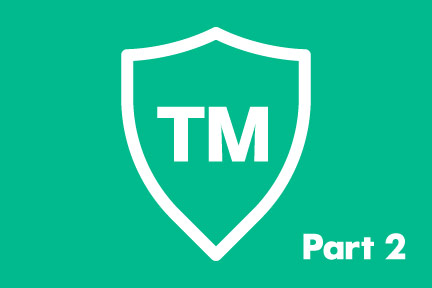Protecting Your Small Businesses Identity: Trademarks and Trade Names (Part 2)

Applying for Trademark Protection
After you’ve determined that your trademarks are not already in use, you will want to file an application for trademark protection. Federal trademark protection provides a legal presumption of your ownership and the exclusive right to use the mark across the US. State protection extends only within the state. Federal registration provides notice to third parties that you are the owner of the mark and adds you to the USPTO (US Patent and Trademark Office) database. It also gives you the right to bring federal action against potential infringers. State registration may provide similar benefits and rights, but only within the borders of that state, and the process will likely be somewhat different than the federal process, as outlined below.
You will be required to pay a filing fee with your federal trademark application. Your application must include information about the format of the mark, identify the “class” or classes of goods and services the mark will be used for, and your basis for filing for trademark protection. You will also need to provide an exemplar showing how the mark is actually being used with your goods/services.
If you are applying for trademark protection under “intent to use”—in other words, you have not yet started using the mark—you must begin using it and pay an additional fee before the mark will be fully registered.
Applications can be submitted online, by using the Trademark Electronic Application System (TEAS), which is faster and less expensive than filing a paper application. Keep in mind that each mark you want to register will require its own application and fees, and that fees are higher if your goods or services fall into more than one class.
What Happens Once the Application is Submitted?
Once your application has been submitted, it may take the USPTO several months to review it and respond to you. Generally, in the USPTO’s response, it will do one of two things: 1) issue publication of the mark, followed by registration of the mark several months later; or 2) send a letter requesting additional information from you.
Approval and Publication
Publication of a mark in a weekly online publication called the Official Gazette occurs approximately one month after the approval department provides notice to the public that USPTO plans to issue a registration for the mark. This begins a thirty day period in which anyone who believes they would be harmed by the registration may file an objection with the Trademark Trial and Appeal Board. No further action is taken until the opposition is resolved. If no opposition is filed within approximately three months after publication, a registration for the mark will be issued.
Request for Additional Information and the Process to Approval
If the USPTO requests additional information from you, you must respond to the request for information within six months. Failure to respond within 6 months is equivalent to abandonment of the application. If you respond to each issue raised in the letter, the USPTO will determine whether the issues have been satisfactorily addressed and will either approve the application and publish the mark or issue a final report, essentially denying the application.
If the USPTO issues a final report, you again have an opportunity to respond by overcoming the issues identified in the report and complying with the requirements outlined, or you can appeal to the Trademark Trial and Appeal Board within six months. If you fail to take any action within six months and/or the USPTO determines that the response does not appropriately address or cure the issues, the application will be considered abandoned unless you have filed a Notice of Appeal.
Maintaining Your Marks
Registration helps to protect your trademarks, but protection doesn’t stop there. You will be required to file specific documents and pay regular fees in order to maintain your registration or risk cancellation.
In addition, if you have registered a federal trademark, the law requires that you use the appropriate registration symbol - ® or the abbreviation “Reg. U.S. Pat. & TM Off” to ensure that no claim can be made that a potential infringer was unaware that the mark belonged to someone else. Failure to do so may impact your ability to obtain money damages in a federal trademark infringement suit. The “SM” (for service mark) or “TM” (for trademark) designations should be used if you have not yet been issued a registration, but are in the process, in order to provide notice to others that you are claiming exclusive rights to those marks.
Your business is responsible for maintaining the integrity of your trademarks by policing the marketplace and your business’s own use of the marks. You are responsible for enforcing your own marks, which may require you to send cease and desist letters or otherwise notify infringers that they are improperly using your marks.
As you can see, the trademark application and maintenance process can be lengthy and complicated. You should generally hire an intellectual property attorney to help you through the trademark application and appeal process to avoid potential problems and delays. To find an attorney experienced in trademark and other intellectual property matters, quickly post a short summary of your legal needs on www.legalserviceslink.com, and let the perfect attorney come to you!
For more tips on protecting your small business, check out our Small Business Legal Guide.
Do You Need An Attorney?
If so, post a short summary of your legal needs to our site and let attorneys submit applications to fulfill those needs. No time wasted, no hassle, no confusion, no cost.

